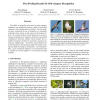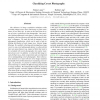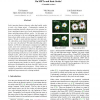CVPR
2012
IEEE
12 years 3 months ago
2012
IEEE
The ability to normalize pose based on super-category landmarks can significantly improve models of individual categories when training data are limited. Previous methods have co...
CVPR
2012
IEEE
12 years 3 months ago
2012
IEEE
We introduce global regularities in the 2.5D building modeling problem, to reflect the orientation and placement similarities between planar elements in building structures. Give...
CVPR
2012
IEEE
12 years 3 months ago
2012
IEEE
Motion segmentation based on point trajectories can integrate information of a whole video shot to detect and separate moving objects. Commonly, similarities are defined between ...
CVPR
2012
IEEE
12 years 3 months ago
2012
IEEE
We cast the problem of recognizing related categories as a unified learning and structured prediction problem with shared body plans. When provided with detailed annotations of o...
CVPR
2012
IEEE
12 years 3 months ago
2012
IEEE
The advances in image acquisition techniques make recording images never easier and brings a great convenience to our daily life. It raises at the same time the issue of privacy p...
CVPR
2012
IEEE
12 years 3 months ago
2012
IEEE
In this work, we investigate how illuminant estimation can be performed exploiting the color statistics extracted from the faces automatically detected in the image. The proposed ...
CVPR
2012
IEEE
12 years 3 months ago
2012
IEEE
In this paper, we propose a bilevel sparse coding model for coupled feature spaces, where we aim to learn dictionaries for sparse modeling in both spaces while enforcing some desi...
CVPR
2012
IEEE
12 years 3 months ago
2012
IEEE
Structure from motion (SFM) aims at jointly recovering the structure of a scene as a collection of 3D points and estimating the camera poses from a number of input images. In this...
CVPR
2012
IEEE
12 years 3 months ago
2012
IEEE
This paper introduces a bundle adjustment (BA) method that obtains accurate structure and motion from rolling shutter (RS) video sequences: RSBA. When a classical BA algorithm pro...
CVPR
2012
IEEE
12 years 3 months ago
2012
IEEE
Scale invariant feature detectors often find stable scales in only a few image pixels. Consequently, methods for feature matching typically choose one of two extreme options: mat...



